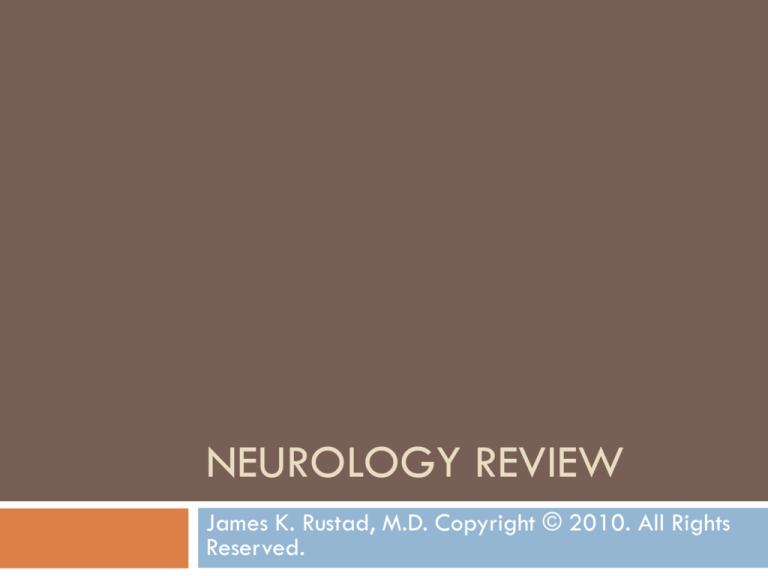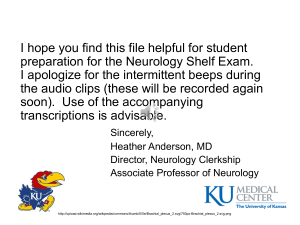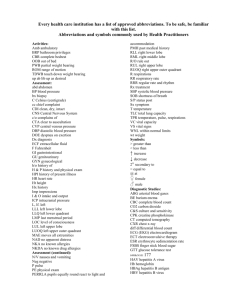
NEUROLOGY REVIEW
James K. Rustad, M.D. Copyright © 2010. All Rights
Reserved.
Lecture Outline
Neuroanatomy Review
Neurotransmitters: Dopamine, Norepinephrine,
Serotonin
Pain: Peripheral Nerve Fibers, Opiate Receptor
Subtypes and Neuropathic Pain Syndromes
Headaches (Tension, Migraine, and Cluster
Headaches)
Brain Hemorrhages (Subdural, Epidural and
Subarachnoid Hemorrhages)
Lecture Outline
Dementias: Alzheimer’s, CJD, Lewy Body, Pick’s,
NPH, SSPE
Neuropathology “power review”: Parkinson’s,
Huntington’s, Duchenne’s, ALS, Guillian Barre,
Myasthenia Gravis, Multiple Sclerosis, Seizure
Disorder, and Brown-Sequard Syndrome.
Stroke Lesion Localization
Aphasias
Neuroanatomy Review
Frontal Lobe: Remember stimulation drives eyes
contralateral and destruction induces ipsilateral eye
movement. Prefrontal Region - Frontal lobe anterior to
motor strip contains executive and inhibitory centers.
Parietal Lobe: Stereognosis, two-point discrimination,
visual association area (perception of visual symbols).
Angular Gyrus (Gerstmann’s syndrome).
Occipital lobe: Visual cortex.
Temporal lobe: Wernicke’s area. Mesial surface is
origin of most partial complex seizures.
Neuroanatomy Review (continued)
Basal Ganglia = Caudate
nucleus, Putamen, Globus
Pallidus, Subthalamic
Nucleus, Substantia Nigra.
Striatum = caudate
nucleus and putamen.
Lenticular Nuclei =
globus pallidus and
putamen.
Nigrostriatal tract
(substantia nigra to
striatum).
Dopamine Metabolism Steps
Phenylalanine
Phenylalanine
Hydroxylase
Tyrosine
Tyrosine
Hydroxylase
(ratelimiting)
DOPA
DOPA
Decarboxylase
Dopamine
Dopamine
Beta
Hydroxylase
Epinephrine
Phenylamine NMethyltransferase
Norepinephrine
Serotonin Synthesis
Tryptophan
Converted by:
Tryptophan Hydroxylase
5-hydroxytryptophan
Converted by:
Amino acid Decarboxylase
Serotonin
Breaks down to 5-HIAA
(5-Hydroxyindoleacetic acid)
Pain
Peripheral Nerve Fibers, Opiate Receptor
Subtypes and Neuropathic Pain Syndromes
Peripheral Nerve Fibers
Type
C fibers
A-delta fibers
Size
Small
Large
Myelin
No
Yes
Conduction Velocity
Slow
Fast
Character
Dull, aching
Sharp, brief
Example
Pancreatic cancer
Burn
Opiate Receptor Subtypes
Receptor
Action
Mu
Analgesia, respiratory depression,
constipation, miosis (pupillary constriction),
euphoria
Kappa
Analgesia, dysphoria,
disorientation/depersonalization
Delta
analgesia
Neuropathic Pain Syndromes
Mononeuropathy: Carpal tunnel syndrome
Polyneuropathy: Diabetic, Alcoholic
Post-herpetic neuralgia
Neuropathic Pain Syndromes
Complex Regional Pain
Syndrome Type I (Reflex
Sympathetic Dystrophy)
Initial noxious event
involving distal
extremity, pain
disproportionate to
injury, not limited to
single nerve distribution.
Associated with edema,
changes in skin blood
flow.
Neuropathic Pain Syndromes
Complex Regional Pain Syndrome
Type 2 (Causalgia)
Sequela of injury to
nerve or major branch
(esp. median, sciatic,
tibial, and ulnar
nerves).
Thalamic Pain: Dejerine-Roussy
Syndrome
Due to thalamic infarct
or other lesion.
Hemi-anesthesia
followed by gradual
return of sensory
function and pain.
Pain contra-lateral to
lesion.
Headaches
Headaches
Tension headache
Dull, bilateral, band
like, chronic in course
and usually related to
stress.
Tx: NSAID, rule out
Major Depression
Migraine: at least five episodes of Episodic Headache lasting
four to seventy two hours
Any two of:
Unilateral
Throbbing
Worsened by
movement
Moderate or Severe
Any one of:
Nausea or vomiting
Photophobia and
phonophobia
Five Phases of Migraine Attack
Phase I: Prodrome
Phase II: Aura
Phase III: Headache
Phase IV: Headache
Resolution
Phase V: Postdrome
Migraine Treatments
Acute
Non-specific: NSAIDS,
Combination
analgesics, Opioids,
Antiemetics,
Neuroleptics.
Specific: Ergotamine,
Dihydroergotamine,
Triptans.
Preventive
Anticonvulsants
(Divalproex,
topirimate)
Tricyclics
Beta-Blockers
Calcium Channel
Blockers
Cluster Headache
M/F 6:1
Unilateral stabbing
headache
Ipsilateral lacrimation
and nasal congestion
with rhinorrhea
Usually triggered by
alcohol use.
Treatment: 100% Oxygen (“Air
Supply”)
Cluster Headache
Rare Disorder (0.1-0.4% of population)
Age of onset 20’s-30’s
Clinical features: Excruciatingly severe, retro-orbital
pain. Radiates to temple, teeth, neck. Last 15-180
minutes.
Ipsilateral autonomic features, pacing, nocturnal
attacks often awaken them.
Triggers: Alcohol, Nitroglycerin.
Cycles usually occur spring and fall and last 4-12
weeks.
Cluster Headaches
Acute
Oxygen 5-10 Liters
Sumatriptan injection
(FDA approved)
Ergotamine
Preventive
Prednisone
Verapamil
Lithium (for chronic
cluster headaches)
Divalproex
Brain Hemorrhages
Subdural, Epidural and Subarachnoid
Hemorrhages
Subdural Hematoma
Suspect in older
patient with new-onset
headache
Follows head trauma
Tearing of bridging
veins
Extra-axial mass
causes focal findings
Waxing and Waning
mental status
“Concave on CT”
Epidural Hematoma
Between bone and
dura
Associated skull
fracture in 85% of
adults
Middle meningeal
artery tear
Brief LOC, initial lucid
period then acute
deterioration
“Convex on CT”
Subarachnoid Hemorrhage
Cause: Rupture of
aneurysm or AV
malformation. Clinical
feature: sudden onset of
“worst headache of my
life”
Studies: CT scan. LP will
show blood and
Xanthochromia (yellow
heme pigment)
Tx: Clip aneurysm
“Athena and Zeus”
Subarachnoid Hemorrhage
Occipito-nuchal
Sentinel bleeds
Most common cause?
Trauma
Dementias
Alzheimer’s Disease
Extracellular
deposition of
amyloid-beta protein,
intracellular
neurofibrillary
tangles, and loss of
neurons.
CT: Atrophy,
ventricular dilatation
Treatment:
CJD vs. AD
CJD
AD
Course
Six months (rapid)
Insidious (years to decades)
Physical findings
Myoclonus
EEG
Periodic complexes, burstsuppression
CSF
14-3-3 protein (>90%),
some false +
Pathology
Spongiform changes
Plaques and tangles
Transmissibility
Person to person and
person to animal
Non-transmissable
Slowing of background
Huey, Dewey and…
…..Lewy Body Dementia
2nd commonest cause
of degenerative
dementia
Progressive cognitive
impairment
Spontaneous onset
Parkinson’s symptoms
Extreme neuroleptic
sensitivity, Sleep
problems, V/H
Pick’s disease
Personality change
Decline in function
Poor social judgment
Inappropriate
Pathology: Prominent
fronto-temporal atrophy,
neuron cell inclusions,
clustered cytoskeletal
elements
“NPH wouldn’t do that!”
Triad: an imbalanced,
wide-based walk or
“shuffle,” urinary
incontinence and
MEMORY PROBLEMS.
Dementia predominantly
frontal lobe in nature,
with apathy, dullness in
thinking, and slight
inattention. Memory
problems are usually
main problem, which can
lead to the misdiagnosis
of AD.
Neil Patrick Harris, aka
“Doogie Howser, MD”
Normal Pressure Hydrocephalus
Dementia
Incontinence
Gait apraxia
(“magnetic gait”)
Subacute Sclerosing Pancephalitis
(SSPE)
Dementia and myoclonus with onset in childhood
Course usually rapid and fatal, may be aborted
with antiviral drugs
CSF has anti-measles antibodies, and EEG shows
periodic or burst-suppression
Cause probably measles or measles-like virus
Neuropathology “power-review”
Parkinson’s, Huntington’s, Duchenne’s, ALS,
Guillian Barre, Myasthenia Gravis, Multiple
Sclerosis, Seizure Disorder, and BrownSequard Syndrome.
Parkinson’s Disease
Cardinal Features
Tremor: resting, “pillrolling,” coarse, 3-5
Hz.
Rigidity: “cogwheel”
Bradykinesia or
akinesia
Minor Features
Festinating gait: small
accelerating steps with
decreased arm swing.
Postural reflex abnormalities
including a positive “pull
test”
Hypophonia, Micrographia
Sleep Disturbances (partly
iatrogenic from dopamine
agonists)
Huntington’s Disease
Atrophy of cerebral cortex and head of caudate
nuclei leads to compensatory enlargement of lateral
ventricles (“bat-wing”).
Excessive Cytosine-Adenine-Guanine (CAG)
trinucleotide repeats (other illnesses with excessive
trinucleotide repeats include: Myotonic dystrophy,
Fragile X syndrome, many forms of Spinocerebellar
degeneration).
Duchenne’s Type Muscular Dystrophy
Sex-linked recessive inheritance with onset in early
childhood
Caused by loss of muscle membrane protein,
dystrophin
Pseudohypertophy (especially in calves)
Proximal weakness: requires arms to arise from
chair or floor
DTRs decreased except for Achilles reflexes (ankle)
Elevated muscle enzymes: CPK, aldolase
UMN vs. LMN
Sign and Symptoms
Upper Motor Neuron
Lower Motor Neuron
Reflexes
Hyperactive
Hypoactive
Babinski sign
Positive (dorsiflexion)
Negative
Muscle atrophy
Absent
Present
Muscle tone
Spasticity
Flaccidity
Fasciculation
Absent
Present
Amyotrophic Lateral Sclerosis
Combines UMN and
LMN symptoms
Asymmetric limb
weakness = most
common presentation.
Limb fatigability,
twitching, wasting, and
stiffness.
Bulbar onset (2nd most
common type) features
dysarthria and
dysphagia.
“Lou Gehrig’s disease”
Clinical Case Scenario
A patient develops progressive weakness two
weeks after a viral infection. What is possible
diagnosis and what tests would you order?
Acute Idiopathic Polyneuropathy
“Guillain Barre Syndrome”
Guillain-Barre
Symmetric weakness, usually beginning in the
legs, and more marked proximally than distally.
Some sensory complaints.
Typical absence of deep tendon reflexes. May be
marked autonomic dysfunction.
Slow conduction velocity
CSF shows increased protein concentration but
normal cell count. Electrophysiology shows
marked slowing of motor/sensory nerve
conduction velocity (denervation and axonal loss)
Guillain-Barre
Treatment: Plasmapheresis or IV IG
Myasthenia Gravis
Insidious onset. Slowly progressive course.
Diplopia, dysarthria, ptosis, extremity and
generalized weakness not conforming to
distribution of any single nerve.
Pupillary responses not affected.
Persistent activity of a muscle group leads to
temporary increase of weakness > restoration of
strength after brief rest.
Myasthenia Gravis
Edrophonium challenge test (screening)
EMG
Confirmatory: Ach receptor antibody test
Tx: Neostigmine, Pyridostigmine (if poor
response: Corticosteroid).
Consider Thymectomy in all patients < 60 yr
unless only extraocular weakness.
Multiple Sclerosis
Relapsing remitting
symptoms
Separated in space
and time
MRI: Multiple
periventricular
plaques in white
matter.
Oligoclonal bands in
CSF.
Internuclear ophthalmoplegia
When the patient
attempts to look to
left, left eye turns
with nystagmus
(abducted eye) and
right eye cannot turn
to left (impaired
adduction).
Location of lesion:
Medial longitudinal
fasciculus.
Young adults: MS
most common cause
Older patients:
vascular diseases.
Seizure Disorder
Partial Seizures: originate in a focal region of a single hemisphere
Simple Partial Seizures: no alteration of consciousness
Secondary Generalization: spreads to both hemispheres
Complex Partial Seizures: alteration of consciousness
Brief Duration (i.e. 2-3 minutes); May have motionless staring or
automatisms (involuntary motor behaviors)
Generalized seizures: involve both cerebral hemispheres from
the outset
(1). Tonic: sudden muscular rigidity
(extension or flexion)
(2) Clonic: generalized rhythmic
jerking of muscles, no initial tonic
phase
(3) Generalized tonic clonic (may
feature epileptic cry, apnea/cyanosis).
Ictal activity 1-2 min; Post-ictal:
incontinence, flaccidity, gradually
return to normal consciousness.
Disoriented, headache, sore mouth
(oral trauma, muscular ache)
(4). Atonic Seizure: brief loss of
muscle tone
(5). Absence ("petit mal") a few
seconds of staring/blank
look/unresponsive
(6). Myoclonic: localized or
widespread: non-rhythmic rapid
jerking movements of muscles
Brown-Sequard Syndrome
Contra: loss of P and T, Ipsi: loss of vib./joint
position, paralysis, hyperreflexia, Babinski
CSF in Meningitis
Diagnosis
Cells
Glucose
(mg/dl)
Protein
(mg/dl)
Opening
Pressure
Normal
0-5
lymphocyte
45-85
15-45
70-180
Aseptic,viral
25-2000,
mostly
lymphocytes
NORMAL
High > 50
Slight
elevation
Bacterial
200-20,000
Polymorphs,
neutrophils
Low <45
High >50
Markedly
high
Tuberculosis
100-1000
lymphocytes
Low <45
High > 50
Moderate
Elevation
LOCALIZATION OF STROKES
The Circle of “whatchu talkin’ bout” Willis?
Anterior Cerebral Artery
Profound lower
extremity weakness
(contralateral)
Stroke may result in
paralysis/sensory loss
in contralateral leg
and foot.
Middle Cerebral Artery
Profound upper
extremity weakness
(contralateral).
Contralateral hemiplegia,
hemisensory loss and homonymous
hemianopia, eyes deviated to side
of lesion. Apraxia/neglect. If left
lobe involved: Global aphasia.
Posterior Cerebral Artery
Contralateral
homonymous
hemianopia, with
macular sparing.
Prosopagnosia
(inability to recognize
faces)
Vertebrobasilar Artery
Vertigo
Nausea and vomiting
“Drop Attack”
Vertical Nystagmus
Dysarthria/dystonia
Ataxia
Labile Blood Pressure
Posterior inferior cerebellar artery
Lateral Medullary or Wallenberg’s syndrome
Sensory loss of the “FACE”
9 and 10 C.N. damage
Limb ataxia
Horner’s syndrome
Spinothalamic sensory loss
Pure Motor Stroke
Weakness of face, arm,
and leg on one side of
body (without cognitive,
sensory, visual
abnormalities) favors
presence of thrombotic
stroke involving
penetrating arteries or
small intracranial
hemorrhage.
Gerstmann’s Syndrome
Finger agnosia
Left-right
disorientation
Agraphia
Acalculia
Dominant parietal
lobe angular gyrus
lesion (stroke or
congenital
abnormality).
Associated with
learning disabilities,
right-sided paresis
and hyperactive DTR’s.
Category
Non-fluent Aphasia
Fluent Aphasia
Previous terms (not
synonymous)
Expressive, Motor, Broca’s,
Anterior
Receptive, Sensory, Wenicke’s,
Posterior
Spontaneous Speech
Output: Sparse < 50 WPM,
single words
Content: Nouns and Verbs
primarily, Dysarthric,
Telegraphic
Output: Plentiful > 100 WPM,
entire phrases, Paraphasias
(incorrect words, clang
associations, neologisms)
Response to Tests
Comprehension Preserved but
Naming and Repeating
impaired
Comprehension Impaired
(variable) and Naming and
Repeating impaired
Associated Deficits
R-sided hemiparesis (arm >
leg)
Minimal hemiparesis,
hemianopia, hemisensory loss
Etiology
CVAs, trauma, other focal
lesions
Focal lesions, sometimes
frontotemporal dementia, AD,
cerebral anoxia
Location of Lesion
Frontal lobe, especially L MCA
Temporal or parietal lobe
Variants of Fluent Aphasia
Conduction
Transcortical (Isolation)
Abnormality
Cannot repeat
Can only repeat
(echolalia), other functions
variable
Nature of Injury
Disconnects arcuate
fasciculus
Isolates language arc from
remainder of cortex
Etiology
Focal lesions
Anoxia, CO poisoning,
occasionally AD
Location of lesion
Posterior temporal lobe
Area(s) surrounding perisylvian arc
Any questions?







